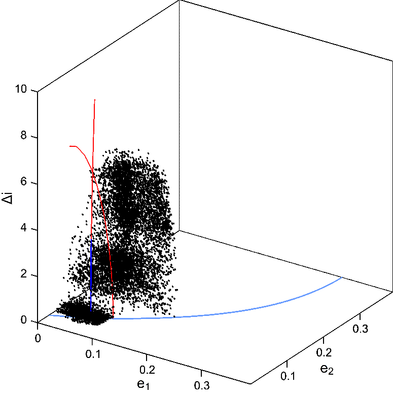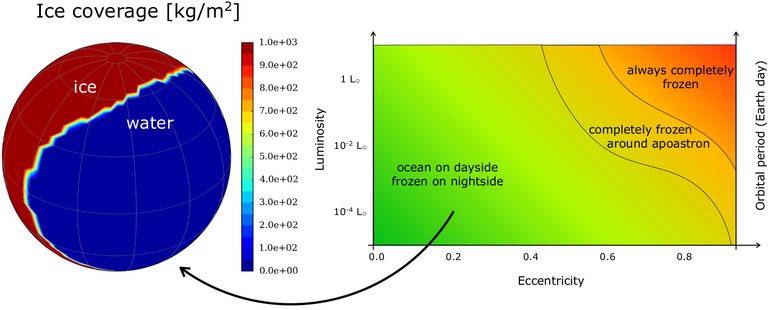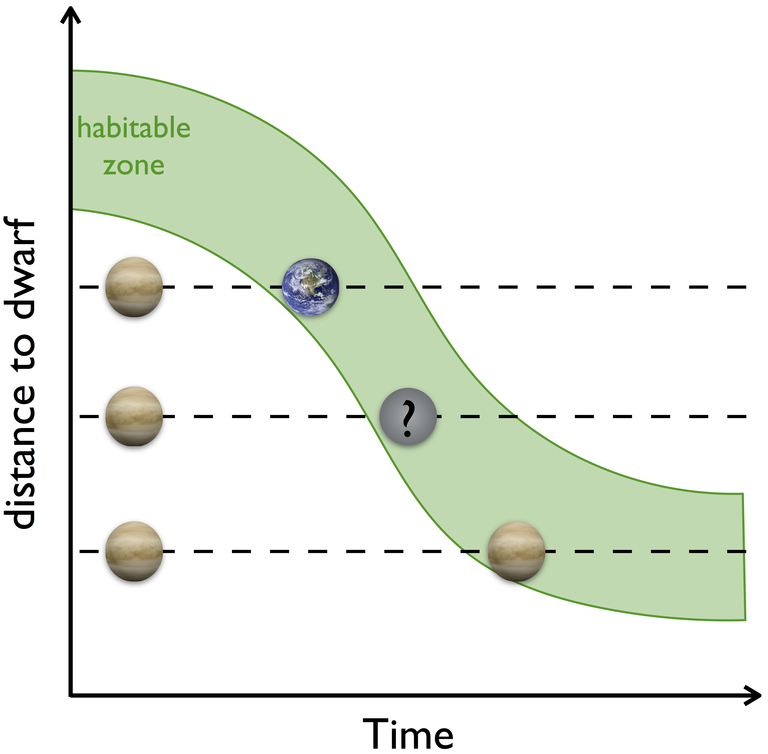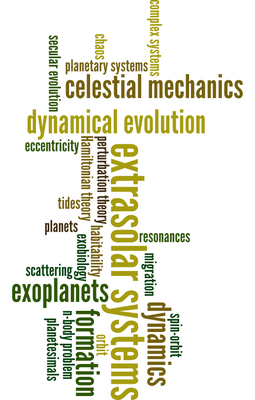Habitability
ORBITAL STABILITY OF EARTH-LIKE PLANETS WITH A GIANT COMPANION
The habitable zone of a planet is usually defined as the region around the star where insulation would keep a temperature such as liquid water can be stable on its surface, which implicitly requires the orbital stability of the body over a biologically significant length of time. The presence of additional bodies in the system restricts the habitable zone to a smaller domain, also called dynamical habitable zone.
Hitherto unprecedented detections of exoplanets have been triggered by missions and ground based telescopes. Many systems consist of more than one planet and the study of planetary orbits in relation to their long-term stability is crucial. Dynamical studies are essential to determine, whether a given planet can remain stable for long time spans, in order for its biosphere to evolve, in the habitable zone. We have studied the sustainability of terrestrial planets under the effect of a giant planet, whether in resonance or not. It is well-known that planets evolving in mean-motion resonances (MMR) prompt the investigation of the dynamics in the framework of the general three-body problem (GTBP). In particular, families of stable periodic orbits constitute the backbone of stability domains, where the long-term stability is guaranteed, in phase space.
We have explored the stability regions, when both the eccentricity of the inner (terrestrial) planet and the semi-major axis of the axis of the outer (giant) planet change, i.e. both non-resonant and resonant configurations are examined. Our study exploits the restricted three-body problem (RTBP) and is primarily focused on the symmetric configurations. Particularly, giant planets on circular and eccentric orbits have been considered. We have shown that an inner terrestrial planet can survive long time spans with a giant eccentric outer planet on resonant symmetric orbits, even when both orbits are highly eccentric. The possible existence of a terrestrial planet has been discussed for 22 detected single-planet systems consisting of a giant planet with high eccentricity (Antoniadou & Libert 2018).

Furthermore, the stability of inclined Earth-like planet in the habitable zone of extrasolar systems has also been investigated, showing the importance of the Lidov-Kozai mechanism for highly inclined and circular orbits of the terrestrial planet (no stable orbit with inclination higher than 40°, see e.g. Funk et al. 2011). Regarding the periodic orbits, the vertical critical periodic orbits (vco) are bifurcation points that generate spatial families of periodic orbits. Since families of periodic orbits constitute paths that can drive the migration process and the vco can excite inclinations, they can prove to be a fruitful venture. Currently, we investigate the maximum inclination of terrestrial planets under the effect of a giant companion, whether in resonance or not, through the location of vco and the computation of stable spatial families for the RTBP.
More information:
Funk, B., Libert, A.-S., Süli, A., Pilat-Lohinger, E., On the influence of the Kozai mechanism in habitable zones of extrasolar planetary systems, Astronomy & Astrophysics, 2011, volume 526, id.A98, 7 pages
Antoniadou, K. I., Libert, A.-S., Puzzling out the coexistence of terrestrial planets with giant exoplanets. The 2/1 resonant periodic orbits, A&A, 2018, submitted
CLimate OF ECCENTrIC PLANETS
An elliptic orbit of a planet implies a variation in its distance to the star and possibly a temporary excursion outside of the habitable zone. A few of the planets found in the habitable zone are on eccentric orbits, raising the question of the potential habitability of these planets that only spend a fraction of their orbit in the habitable zone.
We have investigated the impact of the orbital eccentricity on the climate of an ocean planet in synchronized rotation, receiving the same orbit-averaged flux as the Earth. We have performed sets of 3D simulations using the Global Climate Model LMDz. The atmosphere is composed of N2, CO2 and H2O (gas, liquid, solid) in Earth-like proportions. The dependence of the albedo of ice and snow on the spectra of the host star has also been taken into account. We have also investigated the influence of the type of host star, without taking into account the spectral difference between a low luminosity star and a Sun-like star. We have shown that the higher the eccentricity and/or the higher the luminosity of the star, the less reliable the mean flux approximation.

Similar climatic simulations have also been realized to study the habitability of Proxima-b, an Earth-like planet on a quasi-circular orbit in the habitable zone of our closest neighbor.
More information:
Bolmont, E., Libert, A.-S., Leconte, J., Selsis, F., Habitability of planets on eccentric orbits: the limits of the mean flux approximation, Astronomy & Astrophysics, 2016, 591, A106
Turbet, M., Leconte, J., Selsis, F., Bolmont, E., Forget, F., Ribas, I., Raymond, S. N., Anglada-Escudé, G., The habitability of Proxima Centauri b II. Possible climates and Observability, Astronomy & Astrophysics, 2016, volume 596, id.A112, 29 pages
PLANETS AROUND LOW-MASS DWARFS
Planets around low-mass dwarfs have recently been discovered. Because of their low luminosity, the habitable zone of these objects is located close-in, and thus planets in the habitable zone are close enough to be impacted by tides. Due to the fact that dwarfs cool down with time and enter the main sequence quite late in their lifetime (a few Gyrs, or never for the brown dwarfs), the planets detected in the current habitable zone of the dwarfs were initially in a region where the temperature was too hot to allow surface liquid water before reaching the habitable zone. During this hot early period, which can last up to a few 100 Myr, the water is in gaseous phase in the atmosphere and suffers from the energetic radiations from the dwarf. These radiations can break the water molecules and drive the escape of hydrogen and oxygen atoms. Once in the habitable zone, these planets can have lost enough hydrogen to prevent the recombination of a sufficient quantity of water to qualify the planet as “habitable”.

We have calculated the water loss from planets around brown dwarfs and low-mass stars and applied our methods to two observed planetary systems: TRAPPIST-1 and Proxima Centauri. We have shown that for a non negligible part of the parameter space, planets lose less that one Earth ocean before reaching the habitable zone. We have found that the two inner planets of TRAPPIST are likely to be dry, whereas the third one could have retained a significant part of its initial water content. For Proxima-b, we have also found that the possible presence of water highly depends on its atmosphere and the initial water content. We have also determined observables (di-oxygen pressure, water in the atmosphere) that now should be tested by observing the atmosphere of these planets (for instance, with JWST for TRAPPIST and E-ELT for Proxima).
More information:
Ribas, I., Bolmont, E., Selsis, F., Reiners, A., Leconte, J., Raymond, S. N., Engle, S. G., Guinan, E. F., Morin, J., Turbet, M., Forget, F., Anglada-Escude, G., The habitability of Proxima Centauri b. I. Irradiation, rotation and volatile inventory from formation to the present, Astrophysics & Astronomy, 2016, Volume 596, id.A111, 18 pages
Bolmont, E., Selsis, F., Owen, J. E., Ribas, I., Raymond, S. N., Leconte, J., Gillon, M., Water loss from Earth-sized planets in the habitable zones of ultracool dwarfs: Implications for the planets of TRAPPIST-1, Monthly Notices of the Royal Astronomy Society, 2016, volume 464, issue 3, pp. 3728-3741
Fundings:
- F.R.S.-FNRS ExtraOrDynHa (Extrasolar Orbital Dynamics and Habilitability) Research Project (2013-2017, Grant No. T.0029.13)
- OSE (Orbital Stability of Extrasolar systems) Reseach Project, UNamur fellowship
- Computational resources were provided by the Consortium des Équipements de Calcul Intensif (CÉCI), funded by the Fonds de la Recherche Scientifique de Belgique (F.R.S.-FNRS) under Grant No. 2.5020.11.










